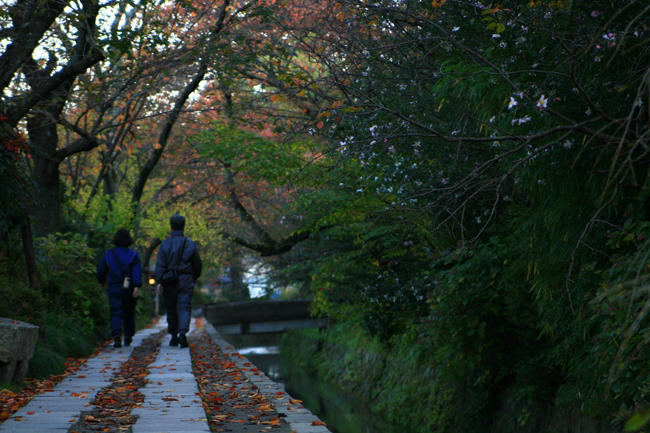There’s no better way to know Kyoto than to eat it.
An excursion to Kyoto would not be complete without the usual rounds: Kinkakuji, Kiyomizu, Heian Jingu. But if you’ve had your share of temple incense, try this one-day excursion around the ancient capital and experience the city through your stomach.
7:00 a.m. Pop in for breakfast at the local favorite Inoda Coffee. Started in 1947, history has it that the shop’s customers would become so involved in conversation that their coffee would cool and the milk and sugar wouldn’t mix well. To solve the problem, Inoda began serving its brews with the milk and sugar already included, a custom that continues to this day. Inoda serves a variety of coffees, but its famous “Arabian Pearl” is worth a try along with the “Kyo no Choshoku” breakfast set. The Kiyomizu branch between Shijo and Gojo opens at 8 a.m., but the original café on Sakaimachidori serves breakfast from 7 a.m.
9:30 a.m. Keep breakfast light, and join the “Traditional Food on the Streets of Kyoto” tour offered by travel agency JTB. The experience begins with a visit to Demachi Futaba, maker of the delicate nama-kashi, one of Japan’s most ancient types of dessert. Although this family-run business creates numerous mochi-based treats, it is best-known for akamame-mochi, a sweet, highly-perishable dumpling whose origins lie with owner Koji Kuromoto’s ancestors in Ishikawa Prefecture. His great-grandfather developed the treat with a special ingredient— adding salt to bring out the delicate sweetness of the mochi—and after some testing he made his debut in the great capital, opening Futaba Kuromoto Shoten in 1895. The delicacy was an instant hit, and over 110 years later the kitchen is still a constant swell of action as Kyotoites line up throughout the day for these treats.
11:00 a.m. For lunch, travel north to Heihachi Jaya, a gorgeous complex of buildings along the ancient Saba Kaido road. For almost a thousand years, this route guided travelers and goods from the Sea of Japan into Kyoto, and at one time rest houses such as this lined the streets. Today, this 430-year-old chaya (tea house) carries on the legacy of offering respite to weary travelers, and although tourists now come by car and bus instead of on foot, Shingo Sonobe and his staff still greet visitors the same way his ancestors did over twenty generations ago. The atmosphere of the garden and great view of the Takano River beat anything that could be found at a crowded inner-city temple, and Heihachi Jaya doles out an upscale version of the same nourishing food travelers dined on hundreds of years ago in the very same spot.
12:30 p.m. No time to rest, as a trip further into the mountains will reveal another of Kyoto’s well-known delicacies: tsukemono pickles. Kyo yasai, or Kyoto vegetables, is a term that lights up the eyes of any Japanese gourmand, and the region’s clean water and fertile soil certainly produce some of the most delicious. Before refrigeration, locals here picked up on the same preservation techniques known the world over to keep stock of their veggies all year-round, and still today Kyoto is known for its pickled vegetables. The 100-year-old Doishibazuke produces some of the best, and visitors can take a tour to check out their age-old pickling techniques as well as try a few samples. Take the opportunity to warm yourself with some ocha-zuke, a soup made by pouring hot tea over rice and mixing in tsukemono. Don’t be bashful, pick up your bowl and slurp.
2:30 p.m. The last leg of the tour brings food-fighters to Junsei near Nanzenji Temple. Junsei specializes in the winter favorite yu-dofu, or boiled tofu. This simple dish embodies much of the spirit of Kyoto; there is a refined art to yu-dofu’s use of only a few simple ingredients to create a lavish delicacy, and much of the flavor is dependent upon the high quality of the water—for which Kyoto is famous. The tofu is boiled in a broth made with konbu seaweed and a bit of yuzu to add a citrusy flavor. It is then dipped in soy sauce with shallots, and the smooth and light taste makes for a rather sensual, Kyoto-esque eating experience. Originally constructed in the Edo Period, the Junsei Shoin estate is also a pleasure to stroll through in any season.
4:00 p.m. For an afternoon pick-me-up, take a stroll down Shijo-dori through Gion, past shops pushing souvenirs and novelties to Tsujiri, a store specializing in Kyoto’s famous green tea. Peruse the selection of loose leaves and other goodies on the first floor, or take a chance and wait in line for a trip upstairs and try one of the famous desserts. Maccha is nice to drink but far more satisfying to eat, especially in a sundae topped with anko, tangerines and sponge cake. If ice cream in winter isn’t up your alley, try the zenzai, a hot soup of sweet azuki beans and roasted mochi, also known as oshiruko in the Tokyo area.
6:00 p.m. After a long day of washoku Japanese dining, evening offers the opportunity to branch out and explore the options. For high-class dining, try the city’s best French at comme ci comme ca in the Higashiyama area, or enjoy something light at local favorite Sarasa Café near Kyoto City Hall. After dinner, join the throngs of tourists and take a stroll down Teramachi-dori for some last-minute omiyage gift purchases.
8:00 p.m. When the sun goes down, the city burgeons with activity right around the Kiyamachi-dori area. There’s plenty to see and do here, but stay out of the tourist trap and head to a pub or a club popular with the locals; look down alleys for the best dives such as Rub-A-Dub for reggae or the hole-in-the-wall favorite ING for some rock. Sent James Club is not to be missed for a more sophisticated night out. Another stop is the Kamogawa River, which provides a fantastic view, as well as the opportunity to play peeping tom on high school couples below.
12:00 a.m. Kyoto is small enough to make the journey back to the hotel by foot or by taxi, so skip that last train for a final bite of the city before bed. Hamid’s Kebab, although not Japanese, is the city’s oldest kebab shop, and serves up mean Middle Eastern food until the wee hours of the night. But a bowl of ramen after a night out drinking is so classically Japanese, that it’s also worth it to make a stop for some kyo-ramen at one of the biggest names in the city, Shinpuku. Located a few blocks from Kyoto station, the area is unfortunately unscenic, which ironically makes it the perfect last stop on this culinary get-a-way from the typical tourist path.
Sponsored by JTB
www.jtbgmt.com/sunrisetour For more information on the “Traditional Food on the Streets of Kyoto” tour and other domestic travel, please visit the Website.
Other posts by Sarah:







